Recent developments offer the possibility of using a security marker that contains a unique code that cannot be forged, and which can be detected at very low concentrations even if attempts have been made to remove it. The way in which these systems work is explained, and some of their advantages and disadvantages for libraries are examined.
Collection security is presently receiving greater attention than ever in libraries, museums and galleries, partly because of the greater prevalence of thefts, and partly because of the increased value of library materials, antiquities and works of art on the market. Recent high-profile cases, such as the theft of maps by Forbes Smiley, or the theft of Munch's The Scream have increased awareness of the vulnerability of our collections to determined thieves.
This paper reviews briefly recent developments in security marking that utilise substances that can be detected in very small concentrations, and which can be combined in very many ways to give a unique identity code. These substances are combined with a fluorescent marker compound and a permanent adhesive, so that when applied to a rough or porous surface it is extremely difficult for a thief to remove all traces, and the traces can be easily located with an ultra-violet lamp.
The idea of using invisible security marks that fluoresce brightly under ultra-violet is not new, but the concept of using a marking system with many possible combinations is novel. This means that not only can every user have a unique identifier (combination of substances), so that their property can be identified unambiguously, it also means that it is impossible for a thief to imitate the mark. This provides protection against substitution, for example, of a copy of a map for an original.
The marker substances that have been proposed or used are:
-
Fluorescent organic compounds. These are detectable using ultra-violet light and have characteristic colours or emission spectra. (Smartwater, no date)
-
Complexes of metals that can be dissolved in organic solvents. Every metal has a characteristic X-ray emission spectrum, and can be detected using a hand-held X-ray fluorescence spectrometer. (Smartwater, no date)
-
Short, specific, synthetic DNA strands. These can be identified by genetic engineering techniques even in very low concentrations.
A wide range of fluorescent organic compounds exists, which can be distinguished by their emission spectra using a portable spectrometer. Figure 1 shows the emission spectra of three typical compounds that glow red, green and blue under ultra-violet light. Many possible compounds could be chosen, all with different emission spectra. Provided that the spectra do not overlap too much, making it difficult to distinguish between them, many different combinations are possible. For example, if we have just three compounds that are either present or absent, there are 7 possible combinations. If we have three compounds that are either present in high concentration, present in low concentration or absent, there are 25 possible combinations.
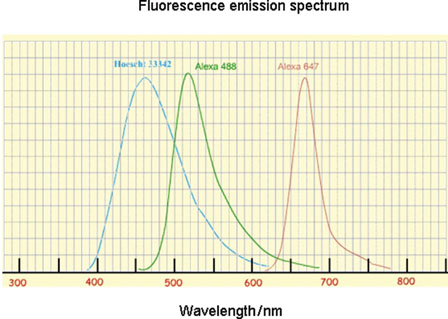
Figure 1: Fluorescence emission spectrum for three dyes – red, blue and green. (Dr Carl Boswell, Dept of Molecular and Cellular Biology, University of Arizona) http://www.mcb.arizona.edu/IPC/spectra_page.htm.
In a more complex example, if we choose one of three red fluorescent compounds plus one of three green fluorescent compounds and one of three blue fluorescent compounds, we can generate up to 198 distinct codes.
This method is limited only by the choice of suitable compounds: for example, they must be stable, colourless under normal lighting and compatible with the adhesive, and their emission spectra must be distinguishable. Identification is quick, non-contact and does not require a sample to be taken.
Metal compounds may also be used as markers. Every element emits X-rays with a distinctive energy when stimulated by an X-ray source, and can be identified using an X-ray fluorescence spectrometer. For example, we could choose from the metals in the first transition series in the periodic table (Figure 2), from titanium (element 22) to zinc (element 30): their emission spectra are shown in Figure 3.
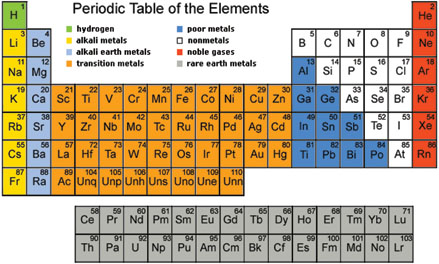
Figure 2: The Periodic Table. Note the first transition series (Ti to Zn) and the lanthanides (Ce to Lu). http://www.elementsdatabase.com.
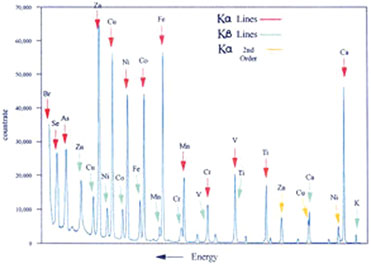
Figure 3: X-ray fluorescence spectrum for the first transition series. Each element has a distinctive emission line. http://en.wikipedia.org/wiki/X-ray_fluorescence, Figure 2.
Alternatively, we could choose from the 13 stable lanthanides or rare earths, from cerium (element 58) to lutetium (element 71) (omitting promethium (element 61), which is radioactive). These are particularly suitable as markers because they are not normally present in library or museum objects. Using 13 metals, we can make a very large number of combinations. For example, if we just allow them to be present or absent, there are 8,191 combinations, but if we allow them to be present in high concentration, present in low concentration or absent, the number of possible combinations rises to 1,594,322. This is clearly sufficient to allow every library or museum to have its own unique combination.
The metals are incorporated into the adhesive carrier in the form of an organic complex, such as an acetylacetonate, which is soluble in organic solvents. In practice, the marker also contains a fluorescent compound to enable the marked area to be identified with an ultra-violet lamp: this area can then be examined with a hand-held X-ray fluorescence spectrometer and the metals identified.
The use of synthetic DNA offers the possibility of generating a very large number of unique sequences which can be used as codes. As is well known, DNA consists of a double helix containing a sequence of the four bases (A, C, G, T) which can be arranged in any order — this means that there are 4100 ways (about 1.6 × 1060) in which a DNA strand consisting of 100 bases can be made. Modern genetic engineering techniques using automated equipment mean that it is possible to synthesise a DNA strand 100 bases long in a few hours.
There are two vital elements to the use of DNA as a security marking system: the strand which contains the code, which is flanked by specific key sequences at each end, and the primers, which are short double strands of DNA, about 20 bases long, that recognise and pair with the key sequences. Each user of the system will have a unique DNA code which is specific to them. The primers will be the same for all users of the marking system served by the same supplier, but will be different from those used by other suppliers. The sequences of the codes belonging to each user, and of the primers, must be kept secret, in a secure database.
In use, a solution of the DNA marker is mixed with an adhesive and a colourless fluorescent dye and is painted onto the item to be protected. To identify the coded DNA, an ultra-violet lamp is used to find the patch of adhesive by its fluorescence and a tiny sample is removed. In principle, as long as it contains one marker DNA molecule, that is sufficient. The sample is dissolved and mixed with a solution containing the primers. The primers will recognise and bind to the key sequences on the coded DNA strand, but not to any other DNA sequence. This means that one strand of coded DNA can be recognised even in the presence of very many other unrelated strands.
The Polymerase Chain Reaction (PCR) is then used to amplify (increase the number) of coded strands. The polymerase enzyme will only recognise and duplicate strands to which the primers have bound, so the reaction is very specific. The duplication process can be repeated until a very large number of copies of the coded strand have been produced (Figure 4). Using automatic equipment, this takes only a few hours. Even one strand of DNA can yield a billion identical daughter molecules.
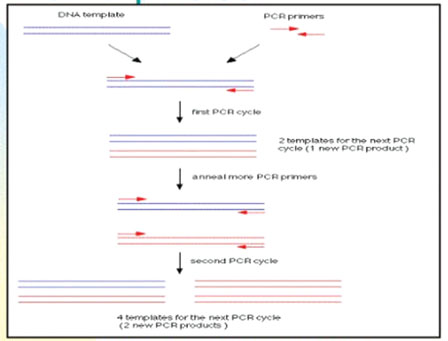
Figure 4: The Polymerase Chain Reaction (from Smith, 2003) http://www.polestarltd.com/ttg/ isspeeches/051403/.
The ability of the primers to recognise the key sequences in the presence of unrelated DNA strands gives an additional degree of security. Even a thief with the necessary biotechnology skills who did not know the key sequences would be unable to pick out the specific marker DNA and would therefore not be able to synthesise it. This provides security against substitution, and guarantees that an object bearing an institution's specific marker does indeed belong to that institution.
Once a large number of identical copies of the marker DNA has been synthesised, they can be sequenced. Again, using automated equipment, this takes less than one day. The sequence can then be read and compared with the sequences in the database in order to identify the owner. The success of this method relies on the extraordinary selectivity of the primer in binding to the key sequences, and the ability of the PCR technique to generate very large numbers of copies of the marker DNA (Smith, 2003).
Some companies that use these marker techniques also use microdots that are mixed with the adhesive. These microdots are less than 1mm in diameter and contain a unique numerical code that identifies the owner plus a contact telephone number for the security company (Figure 5). The advantage is that the microdots can be identified under an ultra-violet lamp and the coded information can be read with a low-power microscope, so that the owner can be found simply by contacting the security company and quoting the code number.
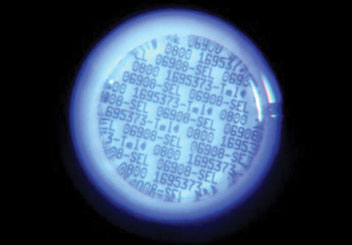
Figure 5: A Selectadot. Less than 1mm diameter, it holds a unique reference number and a contact telephone number. (SelectaMark Security Systems plc) http://www.selectamark.co.uk/product_SelectaDNA.html.
Microdot marker systems are being used for example on expensive motorcycles — the bike is sprayed with microdots so that each part is labelled invisibly. Even if the bike is stolen and broken down into parts, a microdot is likely to remain on each part which can therefore be identified as stolen property (Selectamark, no date).
Before unhesitatingly recommending these systems to libraries and museums, we do need to consider the practical implications. We can divide these into materials questions, organisational questions, and criminological questions.
Considering the materials first of all, conservators are concerned about applying an adhesive that is supposed to be permanent and irremovable to valuable objects. How permanent is the adhesive? How well will it age? Will it affect the aesthetics of the object it is applied to? Will it yellow and peel? We also need to consider the stability of the marker compounds. How long will they last? Fortunately we can be more definite about the stability of DNA: identifiable DNA has been found on archaeological remains many thousands of years old, so we can be reasonably confident that DNA on an object kept under museum conditions will also be stable for a very long time.
Under the heading of organisational questions we must consider the resource implications and feasibility of applying markers to all vulnerable items in a collection. Ideally we need to mark not only the cover of every book, but also every map and plate. The aesthetic argument becomes even more acute here, because in order to defeat the determined thief, the mark must be on the recto, within the image area so that it cannot be trimmed off. We come back then to the traditional library practice of conspicuous stamping (Figure 6).

Figure 6: A map with a prominent ownership stamp just left of top centre. (R. Hurbert, Map of Sicily, c. 1620. British Library Maps K. Top. 2.55) http://www.imagesonline.bl.uk/results.asp?image=062136.
The other organisational questions apply to the security companies. How will they guarantee the security of their databases and the integrity of their employees in the long term? The companies also have different business models. Some charge a fixed fee up-front, while others charge an annual fee to remain on their database. What are the implications of this? What would happen if the company went out of business or was taken over by another company?
Finally, under the heading of criminological questions, we need to ask how successful these systems are in deterring thefts or assisting the recovery of stolen property. These systems are heavily advertised to owners of historic houses etc, and are endorsed by police crime prevention officers. The manufacturers claim that their systems have been effective in reducing the number of thefts of expensive cars and motorbikes, but it is less clear what their effect has been on art theft. Anecdotal evidence from one historic house museum that uses one of these systems is that in spite of warning notices that all the objects on display are security marked, the number of opportunistic thefts has not decreased noticeably, and it has not led to greater success in recovering stolen property.
We also have to consider that while a professional thief may be prepared to spend money on removing ownership marks in order to be able to sell stolen items through the rare book trade for the best possible price, an opportunistic thief will want to sell his loot as quickly as possible through informal channels for whatever price he can get, to a non-specialist buyer who is probably not concerned about the presence of ownership marks, and may even consider that they increase desirability.
In conclusion, these newer systems offer the prospect of unambiguous covert marking that appears very attractive to museums and galleries, but which raises a number of preservation concerns when applied to library collections. There are also concerns about how the companies offering these products will ensure the long-term survival and security of their databases. Finally, and this is true of all security systems, there is little published evidence that they are actually effective in reducing thefts or enhancing the recovery of tolen property.
|
Improvements in or relating to security of articles, goods, vehicles or premises. GB Patent 2245583.
|
|
DNA based steganography for security marking. XIX International Security Printers' Conference; Montreux. 2003 May 14–16. http://www.polestarltd.com/ttg/isspeeches/051403/.
|